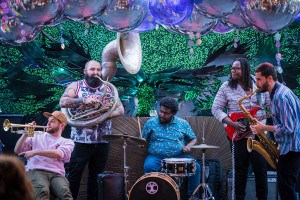The Stories Behind 5 Philly-Area Landmarks on Coins
Philadelphia will always hold a special place in United States coinage history. After all, the nation’s main minting facility is located in the heart of Philly. For years, Philadelphia was the only city where our national coinage was made (circulating coinage is also now made in Denver). In addition to that, much of our country’s history flourishes right here in Philadelphia. So, it’s no surprise that several Greater Philadelphia Area landmarks are also featured on several of our nation’s coins.
Just in time for Independence Day, here are just five of the Philadelphia landmarks you’ll find on U.S. coins. Use them as a guide to celebrate the Fourth this weekend.
The U.S. Constitution
In 1987, the United States honored the bicentennial of our national Constitution with a special commemorative coin featuring this historic document. The 1987 U.S. Constitution silver dollar wasn’t intended to circulate, but these collector coins can be bought for around $25 from almost any coin dealer.
If you want to learn more about the U.S. Constitution, you can stop by the National Constitution Center. Admission is $14.50 for adults, $13 for seniors age 65+ and children age 13 to 18, and $8 for children age 4 to 12. Admission is free to active duty military, museum members, and children age 3 and under.
Liberty Bell
Just two blocks away from the National Constitution Center is the Liberty Bell, a Philadelphia landmark that has been featured on a few United States coins. The Liberty Bell first appeared on a special 1926 half dollar honoring the sesquicentennial of American independence. Twenty-two years later, the Liberty Bell dominated the reverse (tails side) of the circulating Benjamin Franklin half dollar. In 1975 and 1976, an image of the Liberty Bell was superimposed over the moon on a circulating commemorative Eisenhower dollar coin celebrating the bicentennial of our nation’s founding.
Liberty Bell Fun Fact – The Liberty Bell, originally created in 1751 as Pennsylvania’s State House bell, cracked in the early 1840s after some nine decades of heavy use. Attempts to repair the bell were unsuccessful, and a second crack extending from the abbreviation of “Philadelphia” up to the word Liberty would permanently silence the iconic bell.
You can pay a visit to the Liberty Bell Center for free. The visitor center is open daily from 9 AM through 5 pm, with hours extended until 7 pm during the summer.
Independence Hall
Stop by the Liberty Bell and you’ll see just across Chestnut Street another famous landmark: Independence Hall. Originally known as the Pennsylvania State House, where the Liberty Bell tolled in its tower during the 18th century, Independence Hall stands as an historic beacon of freedom and diplomacy.
Independence Hall was featured on circulating Bicentennial-themed Kennedy half dollars in 1975 and 1976 and is also seen on the reverse of $100 bills. Another piece of currency many of us don’t see very often is the $2 bill, which has a replication of a John Trumball painting called Declaration of Independence; it depicts the document’s five-man drafting committee presenting a draft of the historic document in the Assembly Room of what we now know as Independence Hall.
If you want to take a guided tour of Independence Hall, you can stop by any day for free tour tickets or skip the line and pay $1.50 for each reserved ticket. Hours generally range from 8:30 am to 7 pm during summer months.
Old Swedes Holy Trinity Church in Wilmington
Take a short trek on I-95 to Wilmington and you’ll find one of America’s oldest churches. Holy Trinity Church, also known as Old Swedes, is a National Historic Landmark that was dedicated on July 4, 1699. Regarded as the oldest Protestant church in the United States still used for worship, Holy Trinity was featured on the reverse of a 1936-dated half dollar commemorating Delaware’s tercentenary in 1938. The obverse (heads side) depicts Kalmar Nyckel, the ship upon which Delaware’s early Swedish colonists arrived before establishing the church. Originally, Holy Trinity was a Lutheran church, but since 1791 it has served as an Episcopal parish.
The church site, at 606 Church Street, is open various hours throughout the year. It’s best to check out the church’s website or call 1-302-652-5629 for more information about tours, hours of operation, and visiting the church’s museum and research library.
The Delaware River
The mighty Delaware River is not only a vital resource and crucial shipping channel, but it’s also a local landmark that has played host to many historic events. Perhaps most notable of these is George Washington’s legendary crossing of the Delaware on December 25, 1776, an event portrayed on a 1999 50 States quarter honoring our neighbor, New Jersey. Chances are, you’ve got one of these coins in your pocket or purse, if not at home in a change jar.
If you want to take a step back in time, you can visit Washington Crossing Historic Park, at 1112 River Road in Washington Crossing. It’s about 35 miles north of City Center, but it’s worth the drive if you want to soak up some real Delaware River history. Or, you could simply drive along the Benjamin Franklin Bridge in your car to do some crossing of the Delaware of your own.


